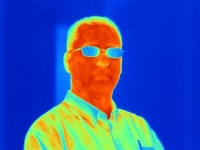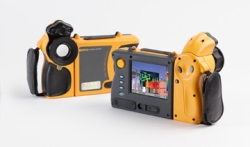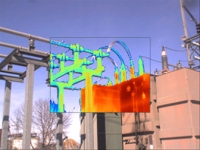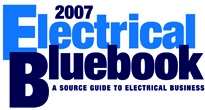
Vol. 1 No. 9
July 2006
- Fluke's Thermal Imaging Guessing Game
- Working in Close Quarters
- Coming Events
- Update your FREE EB Bluebook Listing!
- Enroll in EB's Academic Roundup
- Your August 2006 Electrical Business
FLUKE UNVEILS LATEST THERMAL IMAGING PRODUCTS
 Fluke
Electronics recently paid us a visit here at Electrical Business to
show us its latest offering in the realm of thermal imaging: the Ti
family of portable thermal imagers available in six camera models. The
products are designed for both technicians with little or no
thermography experience, and for predictive maintenance (PdM) experts,
process engineers and consultants.
Fluke
Electronics recently paid us a visit here at Electrical Business to
show us its latest offering in the realm of thermal imaging: the Ti
family of portable thermal imagers available in six camera models. The
products are designed for both technicians with little or no
thermography experience, and for predictive maintenance (PdM) experts,
process engineers and consultants.
The affordable
Fluke Ti20 and Ti30 feature straightforward controls and require very
little training to operate, making them perfect for beginner and
intermediate technicians to perform a variety of daily equipment
maintenance and inspections. Simple point-and-shoot ease-of-use and
intuitive on-screen commands render these cameras among the easiest to
use in the market.
 The
Fluke Ti40, Ti45, Ti50 and Ti55 IR FlexCam® Series IR cameras, on the
other hand, are engineered for advanced technicians and professional
thermographers. These cameras feature great thermal sensitivity,
selectable temperature measurement ranges, image browsing capabilities,
eight-colour linear pallets, 180° articulating lens and on-board
CompactFlash memory. These cameras come standard with new Fluke
SmartView™ image management software: a suite of analysis, management
and reporting tools.
The
Fluke Ti40, Ti45, Ti50 and Ti55 IR FlexCam® Series IR cameras, on the
other hand, are engineered for advanced technicians and professional
thermographers. These cameras feature great thermal sensitivity,
selectable temperature measurement ranges, image browsing capabilities,
eight-colour linear pallets, 180° articulating lens and on-board
CompactFlash memory. These cameras come standard with new Fluke
SmartView™ image management software: a suite of analysis, management
and reporting tools.

The
Fluke Ti IR FlexCam Series cameras are also available with optional
IR-Fusion™ technology that facilitates real time pixel-for-pixel
merging of infrared and visible light images on a single display.
Fluke Ti Series thermal imagers are available now from select distributors. For more information, visit Fluke Canada.
(Note: Top photo is A. Capkun, editor)
WORKING IN CLOSE QUARTERS
Workers
sometimes have to enter spaces that were not designed for humans at
all. Silos, vats, hoppers, utility vaults, tanks, sewers, pipes,
aircraft wings and other ‘confined spaces’ may be difficult to exit and
are often fraught with hazards, explains CCOHS (Canadian Centre for
Occupational Health and Safety).
They may lack oxygen
and contain poisonous substances, making it dangerous for the worker to
breathe. Sometimes, explosive or flammable gases accumulate in confined
spaces without the worker realizing it, and could cause a fire or
explosion if ignited. Confined spaces may be very hot or very cold,
offer limited visibility, and contain various other physical, chemical,
biological or electrical hazards.
Each year, workers are injured or killed while working in confined
spaces. Of particular concern are the poisonous gases in some confined
spaces that can kill a person without warning. Hydrogen sulfide, for
example, may be impossible to detect: high concentrations of the gas
reduce a person’s ability to detect its tell-tale rotten egg odour.
Too often, the victim count increases when someone enters a confined
space in an attempt to save a fallen co-worker. The would-be rescuers
often succumb to the same hazardous conditions themselves, and
represent an estimated 60 per cent of fatalities in confined spaces.
(Such was the case in the recent fatalities at the Sullivan lead-zinc
mine in British Columbia where two of the four dead were paramedics.)
Identifying a confined space
Before entering a workspace, workers should stop to consider whether or not it is a confined space. For example:
- Is it an enclosed or partially enclosed space that has a restricted
entrance or exit, and/or hazardous substances or conditions?
- Is it not primarily intended for human occupancy?
Also, confined spaces can be found both above and below ground just
about anywhere in the workplace. And, despite its name, a confined
space is not necessarily a small space.
If it is determined that the worksite is, indeed, a confined space,
best to consider doing the work outside of that space, if at all
possible.
The air within a confined space should be tested from outside before a
person enters. Using appropriate detection equipment, a trained person
should sample the air throughout the space. Before anyone enters, the
air testing should show a safe amount of oxygen, and absence of any
toxic or flammable gas. If the space cannot be made safe, no person
should enter... plain and simple.
Working in a confined space requires special training, as it requires a
good understanding of gas monitoring, ventilation systems, fire and
explosion prevention and equipment lockout, as well as a thorough
knowledge of the worksite's specific hazards.
Keep reading Electrical Business to learn more about working in
confined spaces, such as developing a confined space health &
safety program and managing the risks from confined spaces.
— With files from CCOHS
COMING EVENTS
Leadership Enhancement and Development (LEAD) Conference
National Association of Electrical Distributors (NAED)
July 27–30
Lake Tahoe, Calif.
Visit www.naed.org (PDF)
AdVenture 2006 (Electrical Sales & Marketing Conference)
National Association of Electrical Distributors (NAED)
August 13–15
Chicago, Ill.
Visit www.naed.org
Atlantic Region Golf Tournament
Electro-Federation Canada (EFC)
August 17
Visit www.electrofed.com
Annual Federation Cup Charity Golf Tournament
Electro-Federation Canada (EFC)
August 29
Visit www.electrofed.com
Canadian Electrical Code 2006 Essentials
Canadian Standards Association (CSA)
September 6–7, Mississauga, Ont.
September 25–26, Winnipeg
Visit learningcentre.csa.ca
Design, Installation & Maintenance of Electrical Equipment in Hazardous Locations
Canadian Standards Association (CSA)
September 11–12, Mississauga, Ont.
September 27–28, Winnipeg
Visit learningcentre.csa.ca
Canadian Electrical Code and Provincial Amendments
Les Stoch (L. Stoch and Associates) for Dalhousie University
September 13-14, St. John's
Call Sheila Gallagher at (800) 565-1179 or Les Stoch at (905) 828-2262
Grounding & Bonding of Electrical Equipment
Canadian Standards Association (CSA)
September 13, Mississauga, Ont.
Visit learningcentre.csa.ca
Communications Systems & EMI
Canadian Standards Association (CSA)
September 14, Mississauga, Ont.
Visit learningcentre.csa.ca
Static Grounding: One Spark, One Chancev
Canadian Standards Association (CSA)
September 15, Mississauga, Ont.
Visit learningcentre.csa.ca
NEC/CEC: A Comparison of Requirements
Canadian Standards Association (CSA)
September 20–21, Mississauga, Ont.
Visit learningcentre.csa.ca
Canadian Airports National Electrical Workshop (CANEW)
Canadian Airports Electrical Association (CAEA) and the Ottawa International Airport Authority
September 25–29
Ottawa
Visit www.canew.ca
Sustainable Lighting Solutions Workshop
Sylvania Lightpoint® Course
September 25–26
Mississauga, Ont.
Visit www.sylvania.com
Arc Flash: Measures for Prevention and Control
Canadian Standards Association (CSA) and Schneider Electric
September 28, Mississauga, Ont.
Visit learningcentre.csa.ca
Want to see YOUR EVENT listed here?
Send information to the Editor at acapkun@clbmedia.ca or fax (905) 727-0017.
UPDATE YOUR FREE EB BLUEBOOK LISTING!

Electrical
Business has put out the call for Bluebook information. The Bluebook is
the most important and influential source guide for the Canadian
electrical landscape.
Don’t miss out, and don’t think this is someone else’s responsibility!
To be included in the Bluebook 2007, visit EBmag.com and take advantage of the online reporting form.
(Tip for success: Be sure to include all branches/divisions to ensure no one gets left out.)
ENROLL IN EB’s ACADEMIC ROUNDUP!
In
the upcoming September 2006 issue, Electrical Business is once again
presenting its roundup of Canadian academic institutions offering
training and education for the electrical field.
Make sure we have your most current scholastic/program information!
Send any updates directly to the editor at acapkun@clbmedia.ca
ELECTRICAL BUSINESS, AUGUST 2006
The
subject of labour relations is vast and varied, and one could go on
about the relationship between employers and employees for days. Writer
Nigel Hesseltine explores the nuances of labour relations in the
electrical industry as he tries to figure how well (or how poorly)
we’re taking care of one another. Specifically, he finds out what
successful ECs across Canada are doing to both attract new employees
and retain existing talent.
And don’t forget, your
August issue looks at some of the newest market offerings in the way of
wiring and wire management, such as: Appleton conduit outlet bodies,
covers and gaskets; Cooper Bussmann power distribution blocks; Ideal
direct burial wire connector; Thomas & Betts wiring duct; and
Legrand thru-wall fittings. That’s just the tip of the iceberg. All
this and more in your August Electrical Business.
Think someone else would enjoy receiving E-Line? Send them to EBmag.com where they can sign up right on the Home Page.
If you wish to be removed from our mailing list click here and put "remove from EB" in the subject line or click here to unsubscribe.
Your email address will not be sold or passed on to any third party. It is only used for magazine-related purposes, such as renewing your subscription and this e-Newsletter. Please see our Privacy Policy for more details.
CLB Media Inc. disclaims any warranty as to the accuracy, completeness or currency of the contents of this e-Newsletter and disclaims all liability in respect of the results of any action taken or not taken in reliance upon information in this e-Newsletter.
© CLB Media Inc., 2006. You may forward and reproduce this e-Newsletter without modification, provided that you include this copyright notice and the above-mentioned disclaimer.
